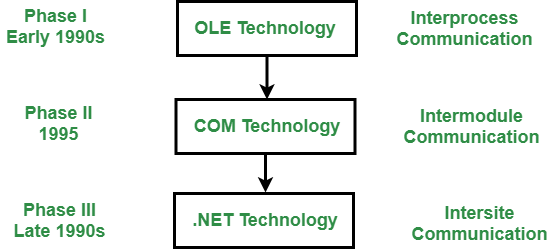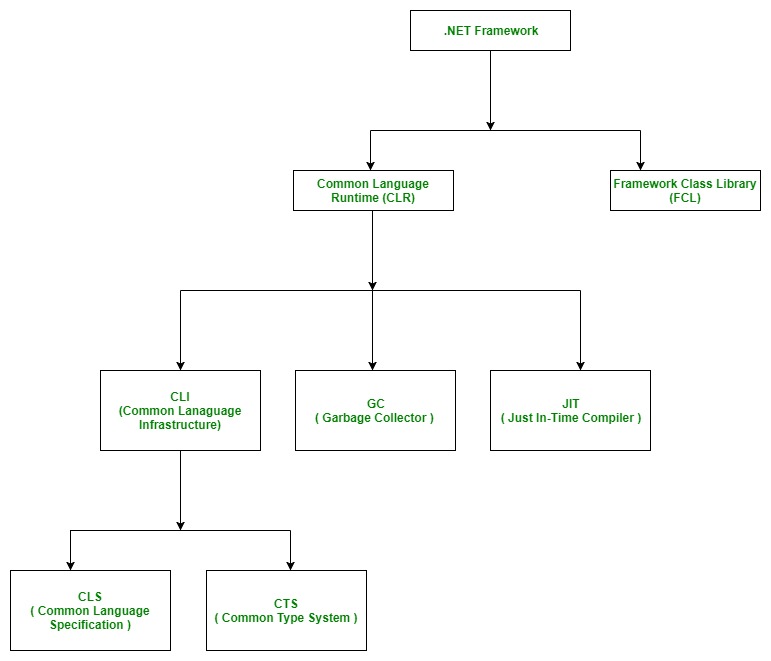Introduction to .NET Framework
Last Updated :
03 Jan, 2024
The .NET Framework is a software development framework developed by Microsoft that provides a runtime environment and a set of libraries and tools for building and running applications on Windows operating systems. The framework includes a variety of programming languages, such as C#, F#, and Visual Basic, and supports a range of application types, including desktop, web, mobile, and gaming applications.
- The .NET Framework includes two main components: the Common Language Runtime (CLR) and the .NET Framework Class Library. The CLR is responsible for managing the execution of code written in any of the supported languages, while the class library provides a large set of pre-built functions and classes that can be used to create a wide range of applications.
- One of the key advantages of the .NET Framework is its support for a variety of programming languages. This means that developers can choose the language that best fits their needs and expertise, while still being able to use the same set of libraries and tools provided by the framework.
- Another advantage of the .NET Framework is its support for a variety of application types. The framework includes libraries and tools for creating desktop, web, mobile, and gaming applications, which makes it a versatile choice for developers working on a wide range of projects.
- The .NET Framework also provides a number of features that help improve the security, reliability, and performance of applications. These include features such as code access security, automatic memory management, and just-in-time (JIT) compilation, which helps improve the speed of application execution.
- The .NET Framework is also designed to integrate with other Microsoft technologies, such as Microsoft SQL Server, Microsoft SharePoint, and Microsoft Office, which can make it easier to build applications that work seamlessly with other Microsoft products.
Overall, the .NET Framework is a powerful and versatile development platform that provides a wide range of tools and libraries for building and running applications on Windows operating systems.
.NET is a software framework that is designed and developed by Microsoft. The first version of the .Net framework was 1.0 which came in the year 2002. In easy words, it is a virtual machine for compiling and executing programs written in different languages like C#, VB.Net, etc.
It is used to develop Form-based applications, Web-based applications, and Web services. There is a variety of programming languages available on the .Net platform, VB.Net and C# being the most common ones. It is used to build applications for Windows, phones, web, etc. It provides a lot of functionalities and also supports industry standards.
.NET Framework supports more than 60 programming languages of which 11 programming languages are designed and developed by Microsoft. The remaining Non-Microsoft Languages are supported by .NET Framework but not designed and developed by Microsoft.
There are three significant phases of the development of .NET technology.
- OLE Technology
- COM Technology
- .NET Technology

OLE Technology: OLE (Object Linking and Embedding) is one of the technologies of Microsoft’s component document. Basically, its main purpose is to link elements from different applications with each other.
COM Technology: The technology of the Microsoft Windows family of the operating system, Microsoft COM (Common Object Model) enables various software components to communicate. COM is mostly used by developers for various purposes like creating reusable software components, linking components together to build applications, and also taking advantage of Windows services. The objects of COM can be created with a wide range of programming languages.
.NET Technology: .NET technology of collection or set of technologies to develop windows and web applications. The technology of .Net is developed by Microsoft and was launched in Feb. 2002, by basic definition, Microsoft’s new Internet Strategy. It was originally called NGWS (Next Generation Web Services). It is considered to be one of the most powerful, popular, and very useful Internet Technology available today.
11 Programming Languages which are designed and developed by Microsoft are:
- C#.NET
- VB.NET
- C++.NET
- J#.NET
- F#.NET
- JSCRIPT.NET
- WINDOWS POWERSHELL
- IRON RUBY
- IRON PYTHON
- C OMEGA
- ASML(Abstract State Machine Language)
Main Components of .NET Framework
Common Language Runtime(CLR): CLR is the basic and Virtual Machine component of the .NET Framework. It is the run-time environment in the .NET Framework that runs the codes and helps in making the development process easier by providing various services such as remoting, thread management, type safety, memory management, robustness, etc. Basically, it is responsible for managing the execution of .NET programs regardless of any .NET programming language. It also helps in the management of code, as code that targets the runtime is known as Managed Code, and code that doesn’t target to runtime is known as Unmanaged code.
Framework Class Library(FCL): It is the collection of reusable, object-oriented class libraries and methods, etc that can be integrated with CLR. Also called the Assemblies. It is just like the header files in C/C++ and packages in java. Installing the .NET framework basically is the installation of CLR and FCL into the system. Below is the overview of the .NET Framework.

Is the .NET application platform dependent or platform independent?
The combination of Operating System Architecture and CPU Architecture is known as the platform. Platform-dependent means the programming language code will run only on a particular Operating System. A .NET application is platform-dependent because of the .NET framework which is only able to run on the Windows-based operating system. The .Net application is platform-independent also because of the Mono framework. Using the Mono framework the .Net application can run on any Operating System including windows. Mono framework is a third-party software developed by Novell Company which is now a part of Micro Focus Company. It is a paid framework.
Release History of .NET Framework and its compatibility with the different Windows version
| .NET Version |
CLR Version |
Development tool
|
Windows Support |
| 1.0 |
1.0 |
Visual Studio .NET |
XP SP1 |
| 1.1 |
1.1 |
Visual Studio .NET 2003 |
XP SP2, SP3 |
| 2.0 |
2.0 |
Visual Studio 2005 |
N/A |
| 3.0 |
2.0 |
Expression Blend |
Vista |
| 3.5 |
2.0 |
Visual Studio 2008 |
7, 8, 8.1, 10 |
| 4.0 |
4 |
Visual Studio 2010 |
N/A |
| 4.5 |
4 |
Visual Studio 2012 |
8 |
| 4.5.1 |
4 |
Visual Studio 2013 |
8.1 |
| 4.5.2 |
4 |
N/A |
N/A |
| 4.6 |
4 |
Visual Studio 2015 |
10 v1507 |
| 4.6.1 |
4 |
Visual Studio 2015 Update 1 |
10 v1511 |
| 4.6.2 |
4 |
N/A |
10 v1607 |
| 4.7 |
4 |
Visual Studio 2017 |
10 v1703 |
| 4.7.1 |
4 |
Visual Studio 2017 |
10 v1709 |
| 4.7.2 |
4 |
Visual Studio 2017 |
10v 1803 |
| 4.8 |
4 |
Visual Studio 2019 |
11 |
| 4.8.1 |
4 |
Visual Studio 2019 |
11 |
| 6 |
|
Visual Studio 2022 |
11 |
Important Points:
- Visual Studio is the development tool that is used to design and develop .NET applications. For using Visual Studio, the user has to first install the .NET framework on the system.
- In the older version of Windows OS like XP SP1, SP2, or SP3, the .NET framework was integrated with the installation media.
- Windows 8, 8.1, or 10 do not provide a pre-installed version 3.5 or later of .NET Framework. Therefore, a version higher than 3.5 must be installed either from a Windows installation media or from the Internet on demand. Windows update will give recommendations to install the .NET framework.
Advantages of .NET Framework:
- Multi-language support: The .NET Framework supports a variety of programming languages, including C#, F#, and Visual Basic, which allows developers to choose the language that best fits their needs and expertise.
- Cross-platform compatibility: The .NET Framework can run on multiple operating systems, including Windows, Linux, and macOS, which provides flexibility in developing and deploying applications.
- Large community: The .NET Framework has a large and active community of developers who have created a wide range of resources, including libraries, tools, and documentation.
- Security: The .NET Framework includes a variety of security features, such as code access security and digital signatures, which can help protect applications from malicious attacks.
- Productivity: The .NET Framework includes a large set of pre-built libraries and tools that can help developers save time and improve productivity.
Disadvantages of .NET Framework:
- Windows dependency: Although the .NET Framework can run on multiple operating systems, it was originally designed for use on Windows operating systems, which means that it may not be the best choice for cross-platform applications.
- Large footprint: The .NET Framework has a large installation footprint, which can make it difficult to deploy applications on systems with limited storage or bandwidth.
- Licensing: Some versions of the .NET Framework require a license, which can add to the cost of developing and deploying applications.
- Performance: While the .NET Framework provides good performance for most applications, it may not be the best choice for high-performance applications that require low-level access to hardware or complex algorithms.
- Learning curve: Although the .NET Framework is designed to be easy to use, it still has a learning curve, especially for developers who are new to the platform or to object-oriented programming in general.
Share your thoughts in the comments
Please Login to comment...